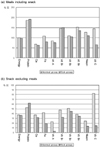1. Choi MH, Kwon KI, Kim JY, Lee JS, Kim JW, Park HK, Kim MC, Kim GH. Monitoring of total sugar contents in processed foods and noncommercial foodservice foods. Korean J Food Sci Technol. 2008. 40:337–342.
2. Kim KN, Kim MY, Kim EJ, Park SM, Hong JS, Cho JS. Dietary behaviors and snack consumption of primary school children in Chungbuk area. J Hum Ecol. 2007. 10:241–250.
3. Jo JI, Kim HK. Food habits and eating snack behaviors of middle school students in Ulsan area. Korean J Nutr. 2008. 41:797–808.
4. Oh KJ, Lee H. Assessment of ADHD with abbreviated Conners rating scale. Korean J Clin Psychol. 1989. 8:135–142.
5. Lahey BB, Pelham WE, Chronis A, Massetti G, Kipp H, Ehrhardt A, Lee SS. Predictive validity of ICD-10 hyperkinetic disorder relative to DSM-IV attention-deficit/hyperactivity disorder among younger children. J Child Psychol Psychiatry. 2006. 47:472–479.

6. Schnoll R, Burshteyn D, Cea-Aravena J. Nutrition in the treatment of attention-deficit hyperactivity disorder: a neglected but important aspect. Appl Psychophysiol Biofeedback. 2003. 28:63–75.
7. Rader R, McCauley L, Callen EC. Current strategies in the diagnosis and treatment of childhood attention-deficit/hyperactivity disorder. Am Fam Physician. 2009. 78:657–665.
8. Cho SC, Shin MS. Diagnosis and Assessment of Mental Pathology for Child. 2006. Seoul: Hakjisa Publishing Inc..
9. Dykman KD, Dykman RA. Effect of nutritional supplements on attentional-deficit hyperactivity disorder. Integr Physiol Behav Sci. 1998. 33:49–60.

10. Chung HK, Park SS. The effect of sugar intake on attention deficit hyperactivity disorder of school children. Korean J Nutr. 1995. 28:644–652.
11. Lee JK, Rhie SG. The effect of carbohydrate processed snacks on middle school students' emotional intelligence. Korean J Community Living Sci. 2008. 19:335–351.
12. Lim KH, Cho BH. The prevalence of ADHD in elementary school children. J Elementary Educ. 2004. 17:235–260.
13. Im HJ, Ghim HR, Sohn JW, Kim YR. The effects of the combined treatment of social skills training and parent training in school-aged children with ADHD. J Child Educ. 2008. 17:225–239.
14. Yun JJ, Kim YH. Problem behaviors related to attention-deficit hyperactivity disorder children. J Hum Ecol. 1999. 2:39–51.
15. Kavale KA, Forness SR. Hyperactivity and diet treatment: a meta-analysis of the Feingold hypothesis. J Learn Disabil. 1983. 16:324–330.
16. Wolraich M, Milich R, Stumbo P, Schultz F. Effects of sucrose ingestion on the behavior of hyperactive boys. J Pediatr. 1985. 106:675–682.

17. Korea Health Industry Development Institute. The third Korea National Health & Nutrition Examination Survey, 2005-Nutrition Survey (I). 2006.
18. Park HY, Kim KN. Relationships among snacks, unbalanced diet, and eating behavior of middle school students. J Korean Home Econ Educ Assoc. 1995. 7:79–89.
19. Cho YK. Survey on screening and subtype of children with attention-deficit/hyperactivity disorder: Based on teachers' observation and rating in the inclusive educare center. Korea J Child Care Educ. 2007. 50:275–295.
20. Goyette CH, Conners CK, Ulrich RF. Normative data on revised Conners parent and teacher rating scales. J Abnorm Child Psychol. 1978. 6:221–236.

21. The Korean Nutrition Society. Dietary reference intakes for Koreans. 2005.
22. USDA Nutritional Nutrient Database for Standard Reference, Release 16. Nutrient Lists. United States Department of Agriculture (USDA) [Internet]. 2004. Accessed on 2009 March 20. Available from:
http://www.usda.gov/wps/portal/usdahome.
23. Monitoring of total sugar and sodium contents. Korea Food and Drug Administration. 2007. Accessed on 2009 March 20. Available from:
http://www.kfda.go.kr/intro.html.
24. Korean Society for the Study of Obesity. Guideline for Childhood and Adolescent Obesity Management. 2006. 158.
26. McCann D, Barrett A, Cooper A, Crumpler D, Dalen L, Grimshaw K, Kitchin E, Lok K, Porteous L, Prince E, Sonuga-Barke E, Warner JO, Stevenson J. Food additives and hyperactive behaviour in 3-year-old and 8/9-year-old children in the community: a randomised, double-blinded, placebo-controlled trial. Lancet. 2007. 370:1560–1567.

27. Striegel-Moore RH, Thompson D, Affenito SG, Franko DL, Obarzanek E, Barton BA, Schreiber GB, Daniels SR, Schmidt M, Crawford PB. Correlates of beverage intake in adolescent girls: the National Heart, Lung, and Blood Institute Growth and Health Study. J Pediatr. 2006. 148:183–187.

28. Braun JM, Kahn RS, Froehlich T, Auinger P, Lanphear BP. Exposures to environmental toxicants and attention deficit hyperactivity disorder in U.S. children. Environ Health Perspect. 2006. 114:1904–1909.

29. Ministry of Health & Welfare. The 4th Korea National Health and Nutrition Examination Survey. 2008.
30. Kim YK. Parent's behavior and perception of their kids' snacking behavior and dietary life education. Korean J Food Cookery Sci. 2010. 26:596–602.
32. Kim WK, Cho S. Sugar and cognitive performance. Korean J Nutr. 2007. 40:Suppl. 50–65.







 PDF
PDF ePub
ePub Citation
Citation Print
Print








 XML Download
XML Download